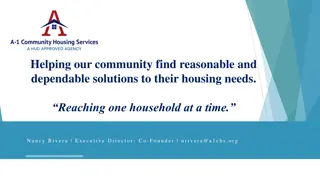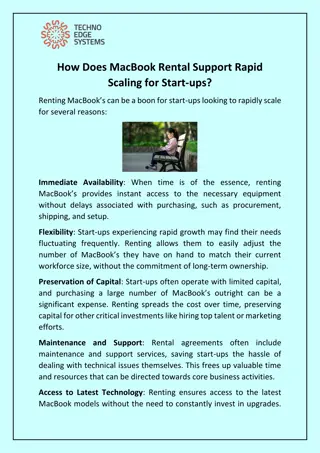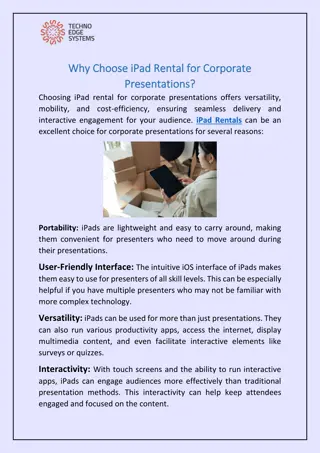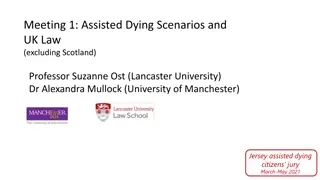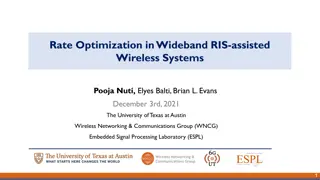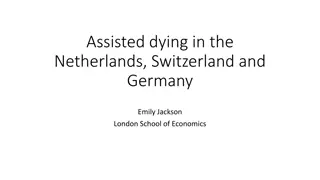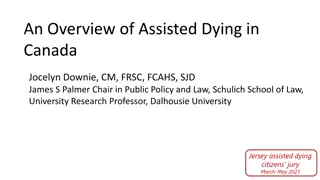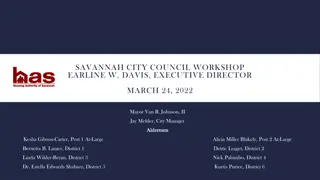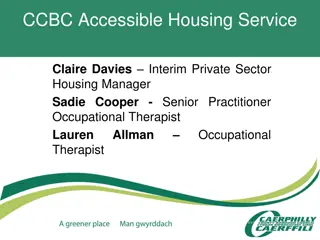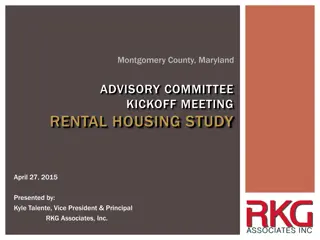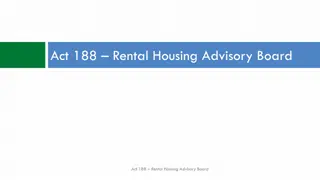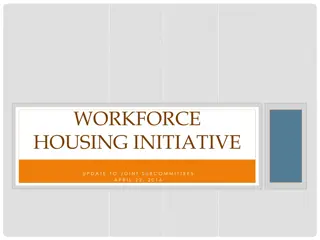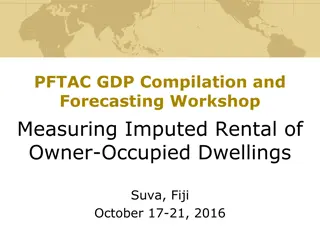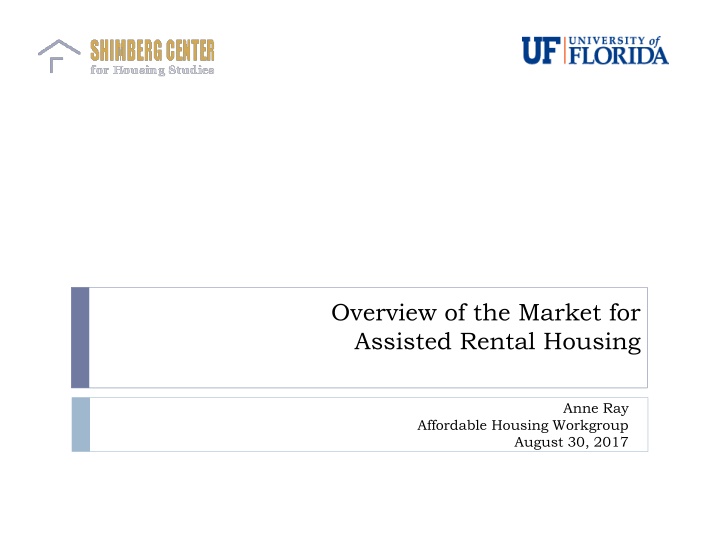
Insights into Florida's Assisted Rental Housing Market Trends
"Explore data on Florida's assisted rental housing market, including renter demographics, affordability levels, and cost burdens. Discover how the rental units and income levels have changed over the years, highlighting the challenges faced by low-income renters."
Download Presentation

Please find below an Image/Link to download the presentation.
The content on the website is provided AS IS for your information and personal use only. It may not be sold, licensed, or shared on other websites without obtaining consent from the author. If you encounter any issues during the download, it is possible that the publisher has removed the file from their server.
You are allowed to download the files provided on this website for personal or commercial use, subject to the condition that they are used lawfully. All files are the property of their respective owners.
The content on the website is provided AS IS for your information and personal use only. It may not be sold, licensed, or shared on other websites without obtaining consent from the author.
E N D
Presentation Transcript
UF Signature Overview of the Market for Assisted Rental Housing Anne Ray Affordable Housing Workgroup August 30, 2017
Rental Market Study terms Low-income: below 60% area median income (AMI) Cost burdened: paying more than 40% of income for rent Affordable unit: rent does not exceed 40% of a given income threshold (% AMI), adjusted for unit size Affordable/available unit: rent is affordable and unit is not rented by a household above the income threshold
Florida has added renters at all income levels since 2000, particularly between 2010 and 2015. Renter Households by Income (% AMI), Florida, Change from 2000 to 2015 3,000,000 2,500,000 885,106 2,000,000 675,615 673,461 584,080 1,500,000 638,561 525,557 533,767 1,000,000 472,999 1,085,289 500,000 939,047 841,015 759,373 - 2000 2005 2010 2015 0-60% AMI 60.01-100% AMI Above 100% AMI Source: U.S. Census Bureau, 2000 Census and 2005/2010/2015 American Community Survey 1-Year Public Use Microdata Sample (PUMS). Excludes student-headed households.
Florida had a net gain of 869,189 rental units from 2000 to 2015. Only 15% were affordable at or below 60% AMI. Rental Units by Affordability Level, Florida, Change from 2000 to 2015 Percent Affordable at 60% AMI 75% 62% 58% 57% 3,000,000 2,500,000 1,241,776 2,000,000 1,056,871 869,071 499,503 1,500,000 1,000,000 1,631,179 1,504,263 1,442,663 1,426,598 500,000 0 2000 2005 2010 2015 Affordable at 60% AMI Above 60% AMI Source: U.S. Census Bureau, 2000 Census and 2005/2010/2015 American Community Survey 1-Year Public Use Microdata Sample (PUMS).
Most low-income renters are cost burdened. Few higher income renters are. Renters Paying More than 40% of Income for Housing by Income (% AMI), 2015, Florida 1,200,000 1,000,000 31,177 800,000 744,662 600,000 156,038 853,929 400,000 482,523 200,000 340,627 0 0-60% AMI 60.01-100% AMI >100% AMI 40% or Less Cost Burden Greater than 40% Cost Burden Source: U.S. Census Bureau, 2015 American Community Survey 1-Year Public Use Microdata Sample (PUMS).
Affordable/Available Units Compares number of renter households in an income group (0-30% AMI, 0-40% AMI, 0-50% AMI, 0-60% AMI) with supply of rental units Affordable: with rent at or below AMI rent limit (40% monthly income) Available: vacant or occupied by income-qualified household (at or below AMI income limit)
Statewide Affordable/Available Units Affordable/Available Units and Renter Households by Income, Florida, 2014 2,500,000 512,773 2,000,000 736,273 1,791,366 1,500,000 1,340,603 595,923 1,025,342 1,000,000 1,982,556 844,246 393,031 1,427,633 651,097 500,000 915,059 449,616 219,760 590,964 150,313 308,068 143,646 - 0-30% AMI 0-40% AMI 0-50% AMI 0-60% AMI 0-80% AMI 0-120% AMI Units, Affordable not Available (Occupied by household above income threshold) Units, Affordable and Available (Occupied by household at or below income threshold or vacant) Total Renter Households in Income Group Source: U.S. Census Bureau, 2014 American Community Survey 5-Year Public Use Microdata Sample (PUMS)
Household Demographics: Size 62% of cost burdened households are 1-2 person 28% are 3-4 person 10% are 5+ person
Household Demographics: Elderly 234,231 cost burdened households (31%) headed by householder age 55+ Includes 37,759 (5%) age 75-84 and 26,561 (4%) age 85+ Highest proportions in southwest coastal regions
Homeless Individuals and Families Individuals 32,533 homeless individuals 16,458 transitional/permanent supportive housing beds Families with children 32,304 homeless families with children 4,200 transitional/permanent supportive housing units
Special Needs Household Estimates Adults with disabilities, receiving SSDI/SSI/VA benefits 107,856 low-income renter households Survivors of domestic violence 8,295 households using emergency shelter (DCF) Youth aging out of foster care 3,173 using post-foster care services (DCF) Total estimate: 119,324 households 16% of statewide total of 756,639 low-income, cost burdened renter households
Farmworkers Farmworkers Unaccompanied workers supply gap: 26,640 beds (61,091 unaccompanied workers 34,451 beds in DOH-licensed camps) Accompanied workers supply gap: 25,305 units (30,896 accompanied worker households 5,591 RD/Florida Housing multifamily units) Highest need counties: Miami-Dade, Hillsborough, Indian River
Assisted and Public Housing Assisted Housing Privately owned Subsidized by Florida Housing, HUD, USDA RD, local housing finance authorities Public Housing Housing Choice Vouchers
Tenant Characteristics: Income Average Tenant Household Income, 2016 FHFC all $24,693 Florida Housing With Rental Assistance $12,554 No Rental Assistance $27,562 Elderly $17,426 Family $25,808 Public Housing $14,567 Other AHI HUD Project-Based Rental Assistance $12,319 RD $16,715 All Florida Renters $47,096 $0 $10,000 $20,000 $30,000 $40,000 $50,000 Source: Shimberg Center for Housing Studies, Assisted Housing Inventory; U.S. Census Bureau, 2015 American Community Survey 1-Year Public Use Microdata Sample (PUMS). All Florida Renters numbers refer to 2015.
Tenant Characteristics: Rent Average Tenant-Paid Gross Rent FHFC all $721 With Rental Assistance $297 Florida Housing No Rental Assistance $821 Elderly $543 Family $756 Other AHI Public Housing $320 HUD Project-Based Rental Assistance $282 All Florida Renters $1,133 $0 $200 $400 $600 $800 $1,000 $1,200 Source: Shimberg Center for Housing Studies, Assisted Housing Inventory; U.S. Census Bureau, 2015 American Community Survey 1-Year Public Use Microdata Sample (PUMS). All Florida Renters numbers refer to 2015.
Tenant Characteristics: Children & Elderly Households with Elderly Members (Age 62 and older) and Children (Under Age 18) 22% FHFC all 47% 34% With Rental Assistance Florida Housing 41% 19% No Rental Assistance 49% 68% Elderly 10% 13% Family 55% 32% Other AHI Public Housing 38% 48% HUD Project-Based Rental Assistance 28% 21% All Florida Renters 33% 0% 10% 20% 30% 40% 50% 60% 70% 80% % with Elderly % with Children Shimberg Center for Housing Studies, Assisted Housing Inventory and U.S. Census Bureau, 2014 American Community Survey 1-Year Public Use Microdata Sample (PUMS)
Expiring subsidies and aging developments pose risks to preservation of assisted housing supply. Expiring subsidies LIHTC 30-Year through 2030: 93 developments (15,891 units) USDA RD Mortgage Maturity (estimated through 2026): 145 developments (7,217 units) Expiring HUD Rental Assistance through 2026: 157 developments (12,132 units) Aging developments 30+ years old: 493 developments (39,798 units) 15-29 years old: 867 developments (95,300 units)




